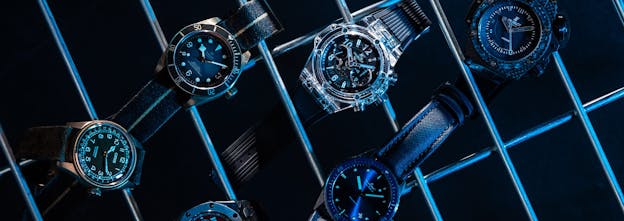Material Science: Watch Materials Explained
While steel, titanium, platinum, and all the shades of gold are par for the course in modern watchmaking, alternative metals, alloys, composites, and other materials continue to make the rounds of watch brands big and small. Keeping matters interesting, there’s a level of one-upmanship prevalent in the watch industry that ensures that there continues to be innovations in case materials.
Even though many of the materials we’re highlighting in this feature aren’t brand new innovations, quite often we’re seeing new approaches or variations of the material than when it first came into the market. These materials are unorthodox, they’re often bold, sometimes colorful creations that at the very least fall under the “not for everyone” moniker. That said, they’re the perfect answer when a collector grows weary of the so-called “usual suspects” of wristwatch categories.
Carbon

From the early days of the forged carbon Royal Oak Offshore Alinghi back in 2007, more and more brands have been getting on the carbon fiber bandwagon in varying ways. While some brands—Hublot in particular—opt to maintain the weave of traditional carbon, in some cases augmenting the carbon fibers with aluminum in order to add color to the case material. Richard Mille on the other hand, with the help of North Thin Ply Technology, developed Carbon TPT, a unique carbon composite that is significantly stronger than conventional carbon fiber. At the pinnacle of Richard Mille’s carbon creations, the RM 50-03McLaren F1 watch weighs an absurdly light 38 grams including its strap, making it the lightest split-seconds tourbillon chronograph on the planet.

Ceramic

Much like carbon, there’s been a fair bit of evolution with ceramic cases in recent years as more and more brands hop on the bandwagon. Chanel was a surprisingly early adopter of the material with their J12 diver-style watch, as was Bell & Ross, who first started dabbling with muted colors like dark blue and green, as well as black cases for their classic BR01 and BR03 models. More recently the Swatch Group has been developing ways to craft the material in more vibrant colors, having launched limited edition blue ceramic models for both Blancpain and Omega. This past year Hublot upped their game in the ceramic category as well, launching the first ceramic watch on the market in a vibrant red hue—generally touted as one of the most difficult colors to execute in the material. We’ve also seen ceramic making waves in more niche independent brands, in particular Hautlence, who tracked down a unique composite/variation of ceramic that has proved far more cooperative with pigments. Using this material for their Vortex Gamma, the CHF170,000 watch can be customized on order in over 1,500 colors.
Bronze

Far from being a new or surprising in the grand scheme of things, bronze watches still have a huge amount of appeal these days due to their unique aging that can either be forced or left to occur naturally over time. First offered up by Panerai, lately we’ve seen a broad assortment of bronze timepieces hit the market from the likes of Oris, Montblanc, Tudor, as well as a number of budget-friendly microbrands in the sub-$1k range. Even Mühle Glashütte, known for their utilitarian and very robust tool watches, launched a bronze version of one of their dive watches that was quickly being touted as the new hero-piece of the brand’s collection. All told there’s little deviation in the category, however depending on the manufacturer, there’s some grey area as to how much copper or aluminum goes into the alloy. Either end of the spectrum still qualifies the material to be called bronze, however you’ll note a significant difference in coloration between the copper-heavy Oris Carl Brashear, and the more aluminum-based Tudor Black Bay Bronze.


Sapphire

Last but not least, sapphire is effectively still king of the heap when it comes to boundary-pushing case materials. The unique transparent material is incredibly hard to work with, however recently we’re seeing the material push its way into the mid-tier of luxury watches. Initially the kind of thing you could only track down by spending six figures (or more), these days we’re seeing other interpretations of the case material from brands like Bell & Ross and (once again) Hublot coming in closer to the $50-60k range. In particular the Bell & Ross BR-X2 Tourbillon Microrotor is an interesting take on the material, as two structural and curved slabs of sapphire make up the front and rear halves of the case, bolted into mainplate that extends outward to act as the center portion of its “sandwich” style case design. In the case of Hublot, it’s once again a matter of dabbling with colors, as the brand unveiled both a muted blue and a red translucent sapphire case for its Big Bang Unico Sapphire models.





